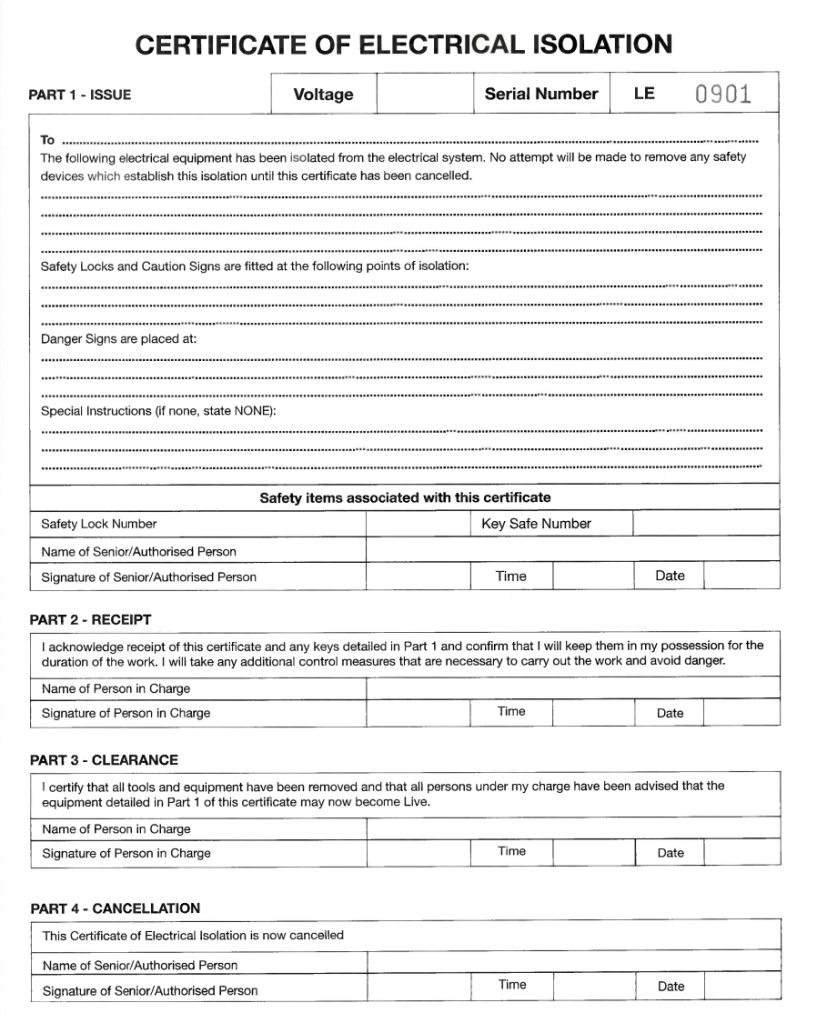
A Certificate of Electrical Isolation is to be issued when non-electrical work is to be carried out on, or near to electrical equipment which must be isolated as a safety precaution for the duration of the work.
An Authorised Person (HV) (the issuer), issues and cancels a Certificate of Electrical Isolation when used on High Voltage equipment.
An Authorised Person (LV) (the issuer), issues and cancels a Certificate of Electrical Isolation when used on Low Voltage equipment.
Prior to offering a Certificate of Electrical Isolation to the recipient, the issuer Shall:
- Identify to the recipient the equipment that has been isolated.
- Identify the points of isolation.
A Certificate of Electrical Isolation may be transferred between persons in charge and may be cancelled by an Authorised Person who was not the original issuer. This process Shall be in accordance with an Approved Procedure.
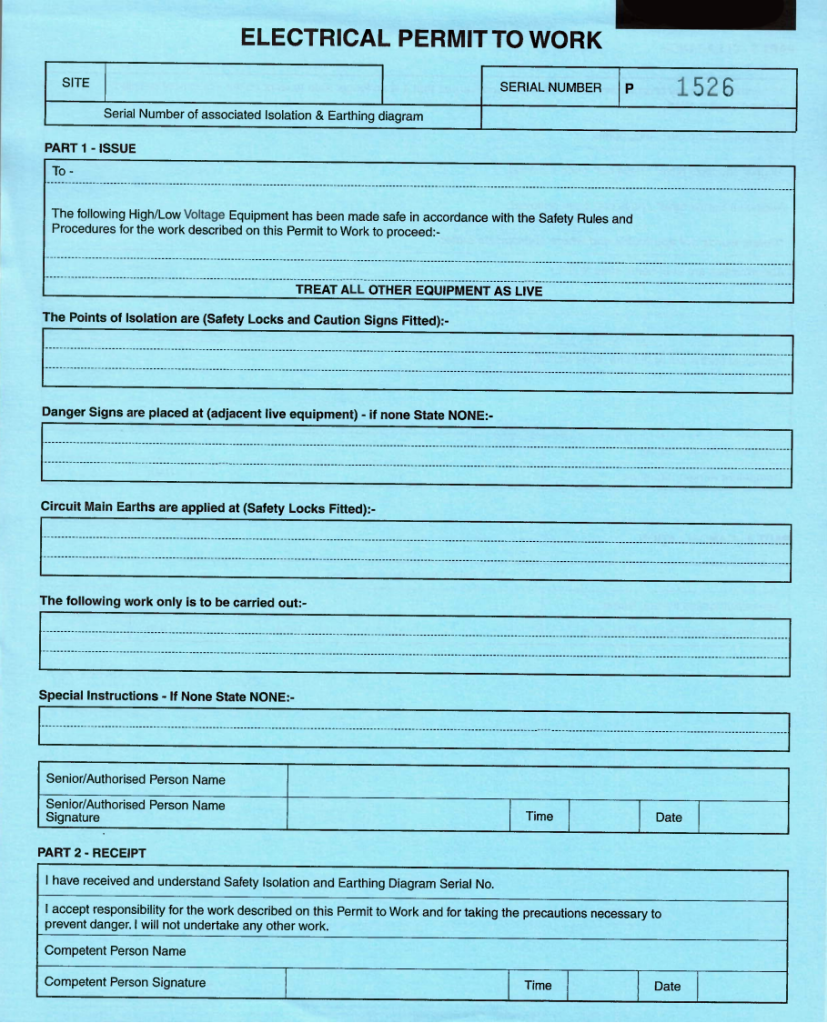
An Electrical Permit to Work is to be issued by a person when work is to be carried out by a person requiring access to Conductors. Such Conductors Shall be isolated, made dead and Earthed (HV only) for the duration of that work.
Prior to offering a Permit to Work to the recipient, the issuer Shall:
- Physically identify by marking the equipment to be worked on in the presence of the intended recipient.
- Show the recipient the Isolation and Earthing Diagram and the safety arrangements at the points of isolation and at the point of work.
- Explain in detail to the recipient the exact extent of the work to be undertaken.
- Draw the attention of the recipient any special instructions or safety measured noted in part 1 of the Permit to Work
- Demonstrate to the satisfaction of the recipient that the equipment is Dead and safe to work on.
- Where it is not practical to prove the equipment Dead prior to issuing a Permit to Work, the issuer […] is to remain with and Personally Supervise the recipient in the removal of covers or plates. The issuer Shall confirm the equipment is Dead […] within the work area before allowing the recipient to assume control of the work.

A Sanction-for-Test is to be issued by a person when testing is to be carried out by a person requiring access to High Voltage Conductors. Such Conductors Shall be isolated, made dead and Earthed at the commencement of the test.
Prior to issuing a Sanction-for-Test, the issuer Shall:
- Physically identify to the recipient the equipment on which the test is to be undertaken.
- Show the recipient the electrical diagram on the Isolation and Earthing Diagram and the safety arrangements at the points of isolation and at the point(s) of the test(s).
- Explain in detail to the recipient the extent of the test to be undertaken.
- Draw to the attention of the recipient any special instructions or safety measures noted in Part 1 of the Sanction-for-Test.
- Demonstrate to the satisfaction of the recipient that the equipment is Dead and safe to test.
- Where it is not practical to prove the equipment Dead prior to issuing a Sanction-for-Test, the issuer having issued the Sanction-for-Test is to remain with and Personally Supervise the recipient in the removal of covers or plates. The issuer Shall confirm the equipment is Dead […] within the work area before allowing the recipient to assume control of the test.
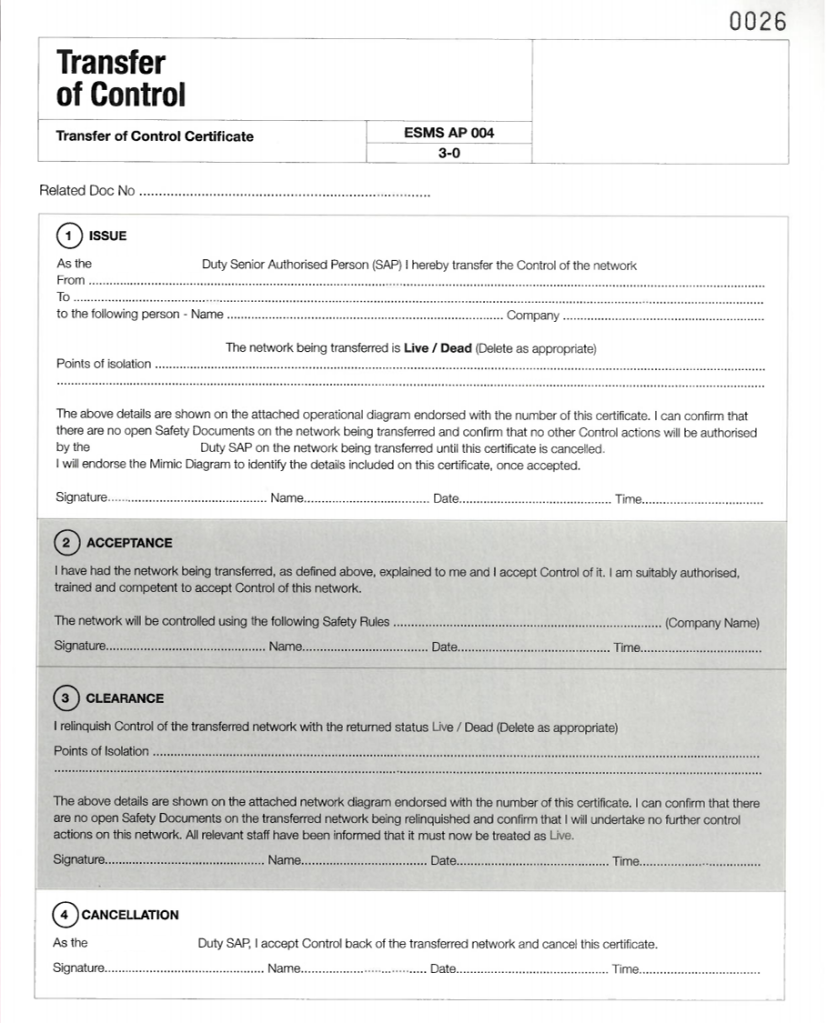
A Transfer of Control Certificate is to be used to transfer responsibility for Control of an existing System from the Duty SAP, on a non-permanent basis. The recipient of the certificate shall be a Company SAP, a contractor or a suitably authorised person from a third party. The Certificate is to be used to ensure that a safe System of work is in place by formally recognising the demarcation of responsibility for Control in two or more parts of a System, or adjacent Systems.
The certificate shall define whether the part of the System to be transferred is Live or dead and also define demarcation points, isolation points and any safety implications. This information shall also be detailed on an accompanying electrical network diagram.
Before the Transfer of Control Certificate is issued, the person who is to issue the certificate Shall:
- Ensure that the recipient fully understands the extent and nature of the transfer,
- Physically identify to the recipient, that [art of the network can be disconnected from its supply in an emergency,
- Ensure that the recipient understands which company’s electrical safety procedures Shall be applied to all activities associated with that part of the network being transferred.

In an area or location that is normally under the control of an Authorised Person for electrical safety reasons, a Limitation of Access may be issued by an Authorised Person (the issuer) for any specified task, other than one for which a Permit to Work or Sanction-for-Test is required, when the Authorised Person considers that additional guidance and warning of Danger is required over and above verbal guidance and warning.
Prior to offering a Limitation of Access to the recipient, the issuer Shall:
- Accompany the recipient to the location where the work is to be undertaken.
- Confirm with the recipient in detail the exact extent of the work activities to be undertaken, including the scope and limits.
- Show the recipient the area in which the work is to be undertaken.
- Indicate to the recipient all items of Live electrical equipment in or adjacent to the working area that are to be identified by Danger Signs.
- Draw to the attention of the recipient any special instruction or safety measure noted in Part 1 of the Limitation of Access, and indicate the safety measures that have been applied by the issuer.
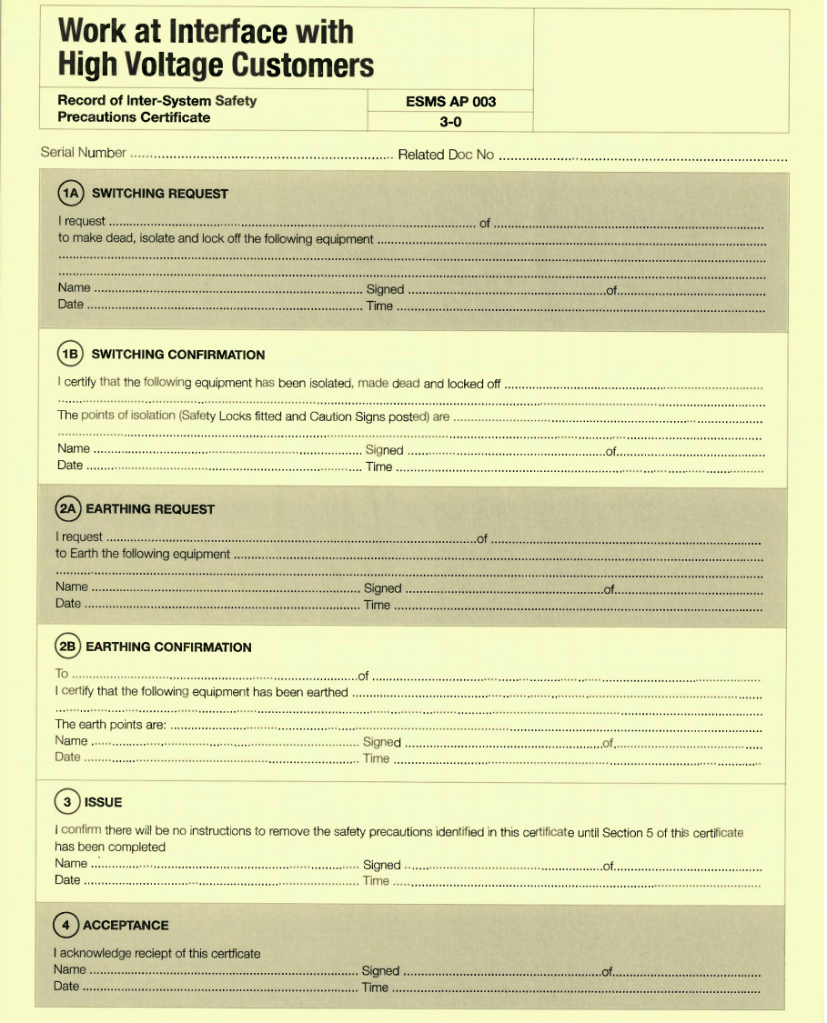
Electricity Distribution Network Operators are required to have a procedure for work or testing at the interface when it is necessary for two or more Senior Authorised/Authorised Persons to work together to establish and maintain safety from the System across the Control boundary.
The requesting party initially defines their requirements for isolation and earthing on the Record of Inter-System Safety Precautions Certificate. Once the responding party has undertaken actions in the correct sequence to achieve the necessary safety precautions, and recorded them on the RISSP Certificate, it can be issued by the responding party confirming the status of the equipment and declaring that there will be no instructions issued to remove the safety precautions previously established before the RISSP Certificate is cancelled by the requesting party.
There are three situations in which this procedure will be used:
- Work carried out by the customer on their own equipment which can be energised by the Company or the customer.
- Work carried out by the Company on its own equipment which can be energised by the Company or the customer.
- Work to be carried out simultaneously by both the Company and the customer on their own equipment which can be energised by the Company or the customer.
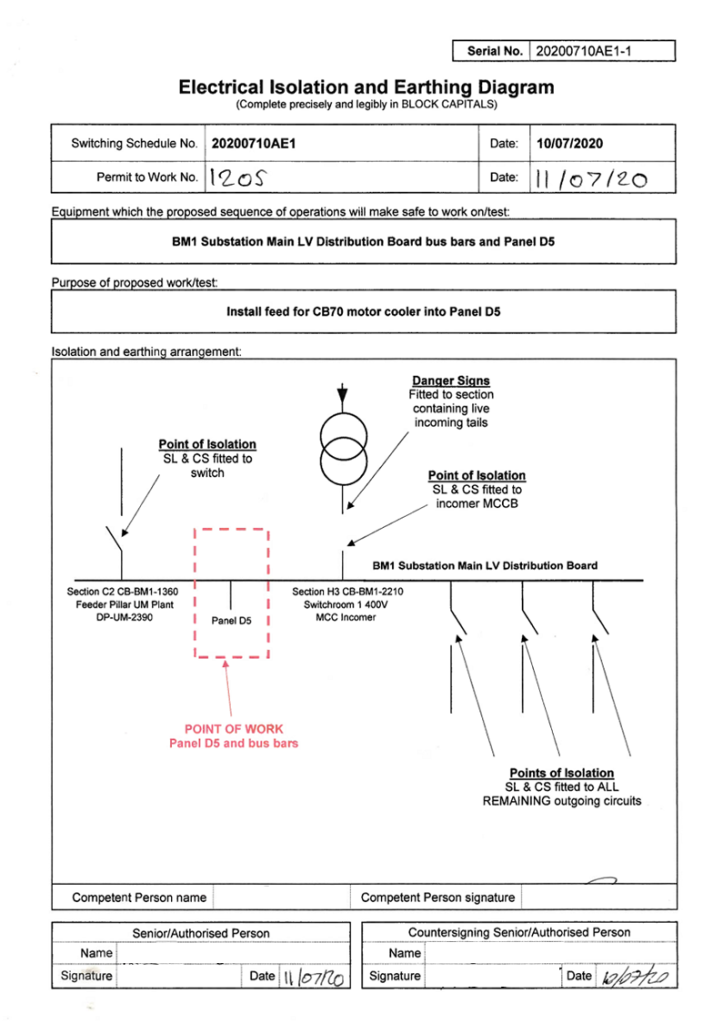
Prior to the issue of any Permit to Work or Sanction-for-Test, an Isolation and Earthing Diagram Shall be completed illustrating the safety arrangements at the points of isolation and the place of work, which have been implemented to make the equipment safe for the execution of the work or test.
An Isolation and Earthing Diagram Shall show:
- The name, signature and location of the originating Senior Authorised Person.
- The name, signature and location of the countersigning Senior Authorised/Authorised Person.
- The date the countersigned programme is to commence.
- The purpose of the proposed work or test.
- The equipment that the proposed sequence of operations will make safe for the work or test to be undertaken.
- The cables and equipment to be worked on or tested.
- The points of isolation.
- The points of Earthing.
- The points of work or test.
- Any Safety Locks and Safety Signs fitted.
- The System ‘as is’ when ready for the issue of the Permit to Work or Sanction-for-Test.
- The serial number of the associated Switching Schedule, Permit to Work and/or Sanction-for-Test.
The Isolation and Earthing Diagram Shall then be attached to the Permit to Work or Sanction-for-Test prior to its issue.
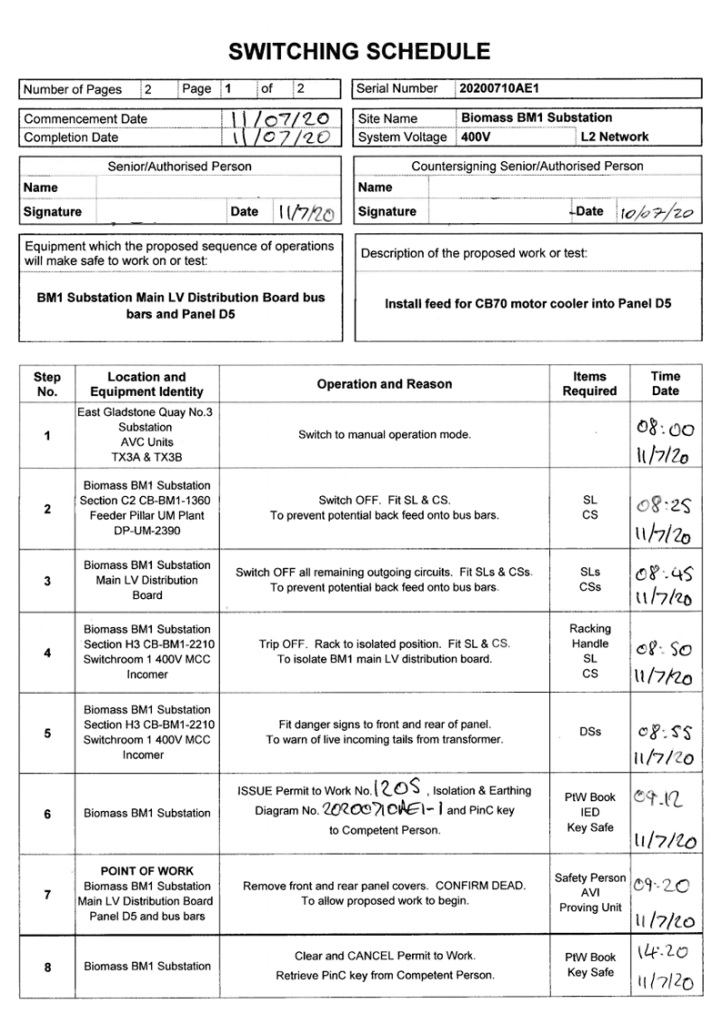
A Switching Schedule is to be prepared by a Senior Authorised Person, detailing the intended sequence of safety operations to be performed to make the relevant equipment safe for the execution of the work or the test. When a Switching Schedule has been completed it Shall be countersigned by another Senior Authorised or Authorised Person who has a detailed working knowledge of the particular System involved.
The Senior Authorised Person Shall satisfy himself of the presence, if any, of any Operational Restrictions on the equipment involved in the switching.
The Switching Schedule Shall detail the sequence of operations to be undertaken up to and including the issue and cancellation of a Certificate of Electrical Isolation, Permit to Work or Sanction-for-Test and the System restoration process, including:
- The location, including any name and identification code, at which each operation is to be performed.
- The identity of each item of switchgear to be operated.
- The operation to be performed and the reason for the operation.
- Any “Items Required” e.g. keys, locks, Safety Signs, Protective Equipment, handles, documentation, etc.
- The requirement for an Accompanying Safety Person for a specific operation.